To set up your interior design business, start by defining your services—residential, commercial, or e-design. Identify your design style and create a mood board to clarify your vision. Choose a unique business name that resonates with your target audience and register it to secure your online presence. Build a professional website to showcase your portfolio, including high-quality images of past projects. Develop a marketing strategy using social media and industry networking. Finally, plan your finances to guarantee stability. There’s a lot more to explore on each step to help you succeed. Consider offering free consultations or design workshops to attract potential clients and demonstrate your expertise. Additionally, create an effective pricing strategy that reflects the value of your services and sets you apart from competitors. When developing your interior design plan, remember to prioritize creating spaces that are both functional and visually appealing. For more interior design plan tips, consider seeking mentorship or joining professional organizations to stay updated on industry trends and best practices.
Key Takeaways
- Define your services by identifying various types like residential and commercial, and create tailored packages for different client needs and budgets.
- Choose a unique business name that reflects your design style and resonates with your target audience, ensuring it’s legally available.
- Build a professional website showcasing your portfolio with high-quality images and SEO-optimized content to attract potential clients.
- Develop a comprehensive marketing strategy using social media, content marketing, and networking to enhance your visibility and credibility in the industry.
- Establish strong client relationships through initial consultations, regular updates, and detailed contracts to ensure transparency and satisfaction.
Define Your Services
Defining your services is essential for establishing a successful interior design business. Start by clearly identifying the types of services you’ll offer, whether it’s residential design, commercial design, e-design, or specialized options like eco-friendly design. This clarity helps potential clients understand exactly what you provide as an interior designer.
Next, create distinct service packages tailored to different client needs and budgets. By outlining what each package includes, you avoid confusion and set clear expectations. Develop compelling service descriptions that highlight your unique selling points and the specific problems your design services solve.
Consider offering a la carte options for additional services, but keep them limited to maintain focus and avoid overwhelming clients with choices. It’s vital that the scope of work for each service is well-defined.
Include deliverables like mood boards, paint palettes, and project timelines to manage client expectations effectively. This approach not only streamlines your operations but also enhances client satisfaction.
Identify Your Design Style
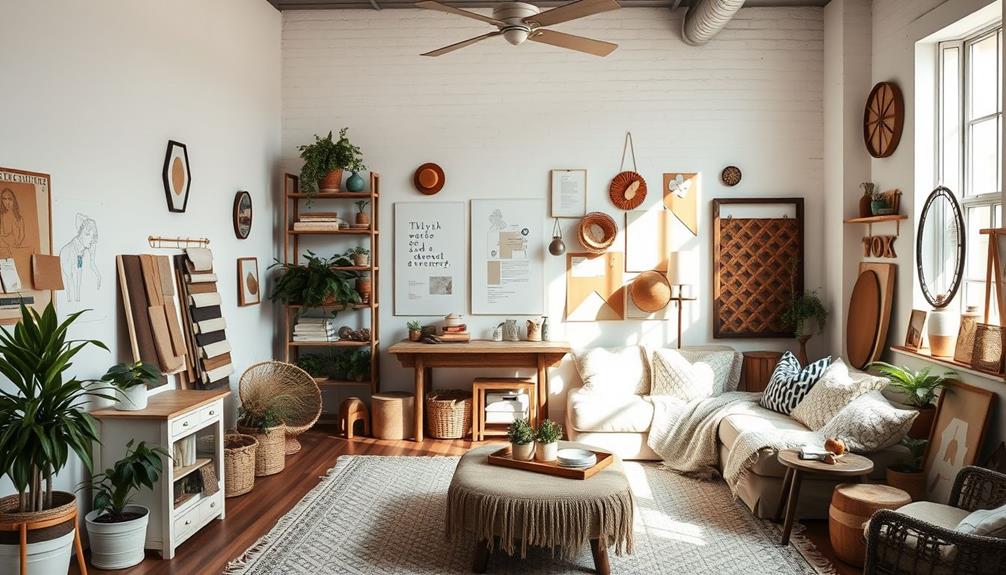
To create a successful interior design business, you need to identify your unique design aesthetic and target market.
Explore various styles, from modern to traditional, and see what resonates with both your vision and potential clients.
This clarity will help you tailor your services and attract the right clientele.
Unique Design Aesthetic
Often, identifying your unique design aesthetic is essential for attracting the right clientele and standing out in a crowded market. Start by researching various design styles, like mid-century modern, rustic, or industrial, to find what resonates with your personal taste and potential clients. For instance, incorporating elements from modern farmhouse decor trends can help you connect with clients who appreciate warmth and simplicity.
This exploration helps you carve out a niche that aligns with your skills and interests.
Creating a mood board can be incredibly helpful. Collect images, color palettes, materials, and layout inspirations that reflect your style preferences. This visual representation clarifies your design vision and can guide your projects.
Additionally, stay updated on current design trends and think about how they can be integrated into your unique aesthetic. This approach allows you to appeal to modern clients while maintaining your individuality.
Establishing a niche, such as eco-friendly design or vintage restoration, enhances your brand identity. This specialization not only differentiates you but also attracts specific client demographics seeking those services.
Target Market Identification
Understanding your unique design aesthetic naturally leads you to identify your target market. By pinpointing your design style, whether it’s mid-century modern or rustic farmhouse, you can attract specific clients who resonate with your vision.
This focus not only enhances your target market identification but also allows for effective niche marketing strategies that highlight your strengths.
Research shows that 70% of consumers prefer working with designers who specialize in a particular style, underscoring the importance of defining your aesthetic. This clarity helps you create a cohesive portfolio that appeals to your ideal clients, setting you apart from competitors.
Moreover, knowing your design style clarifies your service offerings, whether you provide full-service design or tailored e-design solutions.
Engaging with your audience through surveys or social media can give you deeper insights into their preferences, enabling you to refine your style and service packages.
Choose a Business Name
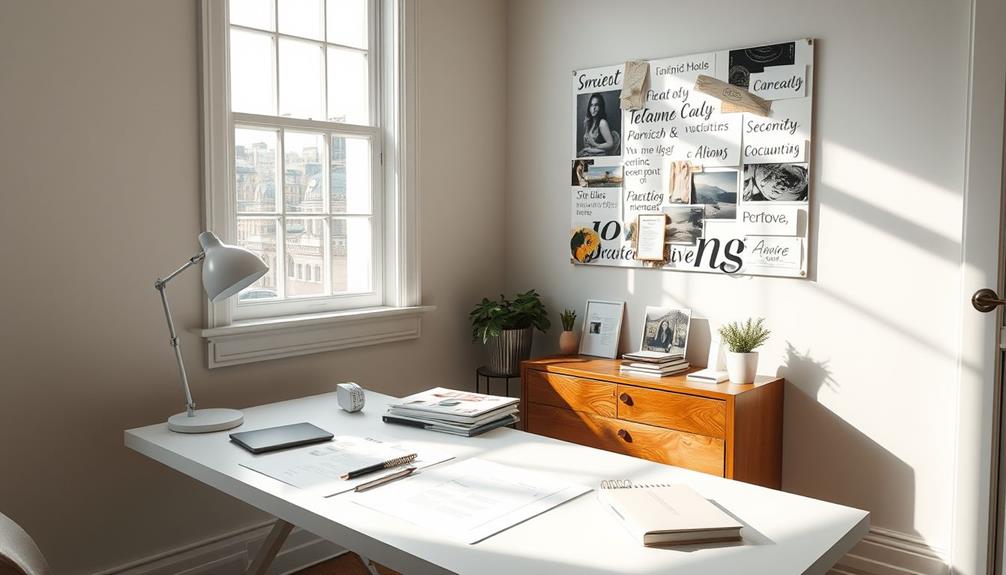
Choosing a business name is essential for establishing your brand identity in the interior design world.
You’ll want a name that’s unique and relevant to your style, while also making sure it’s not already in use.
Once you’ve settled on a name, register it with the appropriate state agency to comply with legal requirements and protect your brand.
Name Uniqueness and Relevance
Selecting a business name is essential for establishing your interior design brand. You want a unique name that reflects your design style and resonates with your target audience. This name should convey the essence of your services, making it clear what clients can expect from you.
Before settling on a name, conduct a thorough search to confirm its uniqueness. Check business registries and domain availability to avoid potential legal conflicts with existing businesses.
Remember, a name that’s easy to pronounce and remember will help clients connect with you more easily; complex names can create confusion and hinder brand recognition.
Incorporating your personal name or initials can add a personal touch, enhancing trust and familiarity. This approach helps establish a strong brand identity that stands out in the competitive interior design market.
Registration and Legal Considerations
Registering your business name is an important step in establishing your interior design firm. Your business name not only reflects your design style but also resonates with your target audience, enhancing brand recognition. Before moving forward, conduct a thorough search to verify your chosen name is unique and isn’t already in use to avoid legal conflicts.
Consider incorporating your personal name into the title, as this adds a personal touch and builds trust with potential clients. Once you’ve settled on a name, register it with your state’s Secretary of State office or a similar entity, which typically involves completing an application and paying a fee.
Additionally, securing a domain name that matches your business name is vital. This helps establish a professional online presence and supports your branding efforts.
Here’s a quick overview of the process:
| Step | Action |
|---|---|
| 1. Name Selection | Choose a unique business name |
| 2. Registration | Register with the Secretary of State |
| 3. Domain Registration | Secure a matching domain name |
Build Your Website
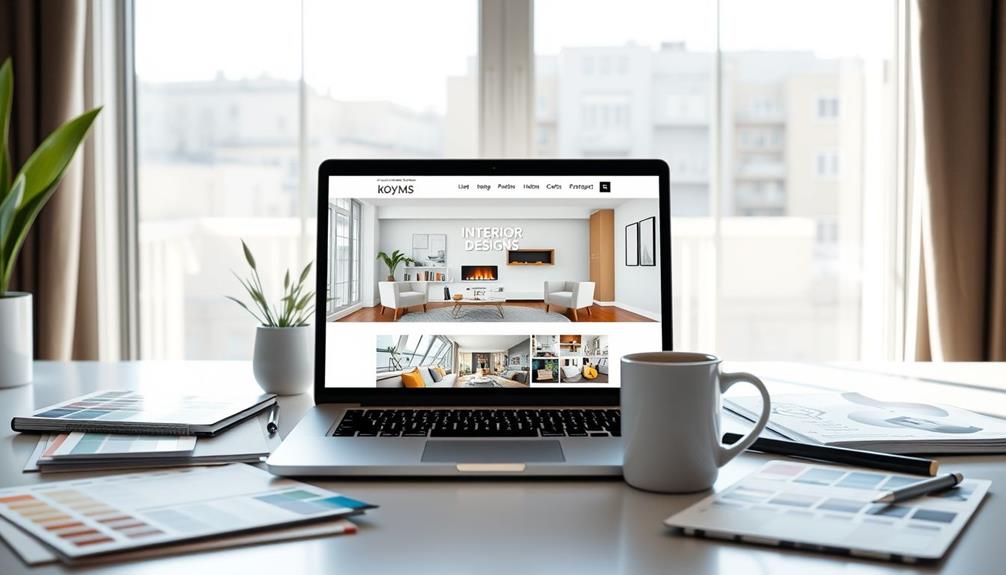
Building a website for your interior design business is vital, especially since it serves as your online portfolio and first impression for potential clients. Start by registering a memorable domain name that reflects your brand and is easy to spell, which enhances your online visibility.
Platforms like WordPress or Squarespace offer user-friendly templates, allowing you to build your website without needing extensive coding knowledge. Additionally, incorporating effective keyword clustering can enhance your SEO strategy and improve content discoverability.
Incorporate high-quality images of your design work, including before-and-after photos, to effectively showcase your portfolio. These visuals can capture the attention of potential clients and demonstrate your design skills.
Don’t forget about search engine optimization (SEO) to improve your website’s visibility in search rankings. Use relevant keywords, meta descriptions, and alt text for images to attract more visitors.
Lastly, make certain that your website is mobile-responsive and loads quickly. Given that 53% of mobile users abandon sites that take longer than three seconds to load, a fast and responsive design is essential.
Create a Portfolio
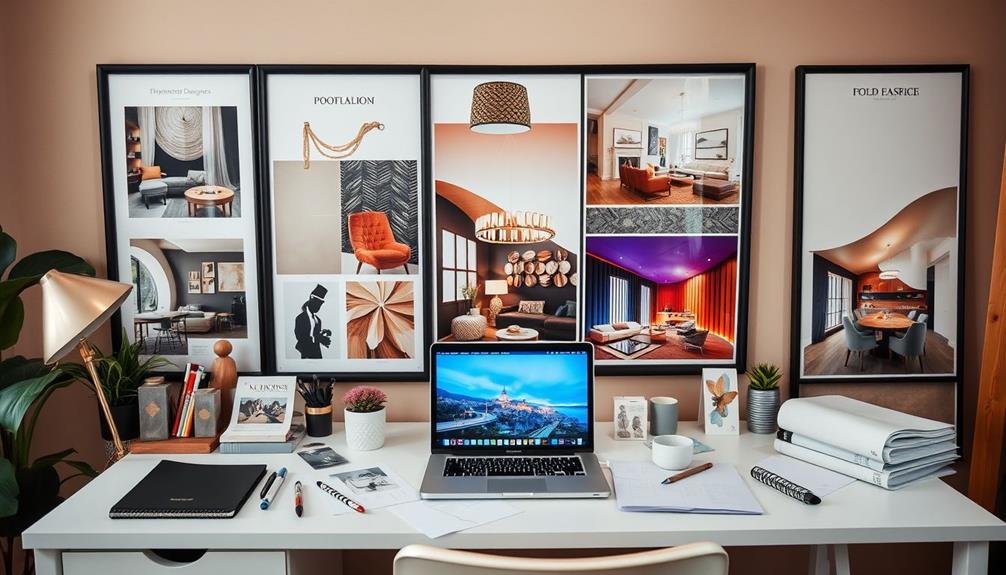
A strong portfolio is essential for showcasing your interior design skills and attracting potential clients. To create a portfolio that stands out, showcase a diverse range of projects that highlight various styles, spaces, and design elements. This versatility appeals to a broader clientele.
Include high-quality before-and-after photos to visually illustrate your design impact and the transformational journey of each project. These images speak volumes about your ability to transform spaces.
Incorporate detailed drawings and renderings, both 2D and 3D, to highlight your design concepts and spatial planning skills, making it easier for potential clients to envision your ideas.
Don’t forget to feature client testimonials alongside project descriptions. These testimonials should describe the challenges you faced, the solutions you provided, and the overall experience of working with you. This adds credibility and relatability to your work.
Lastly, regularly update your portfolio with recent projects and trends to keep it fresh and relevant. This guarantees potential clients see your current capabilities and style evolution, making your portfolio an effective tool in landing new clients.
Develop a Marketing Strategy

An effective marketing strategy is essential for launching and sustaining your interior design business.
Begin by establishing a strong online presence with a professional website that showcases your portfolio, services, and client testimonials. Optimize it for SEO to attract potential clients effectively.
To further enhance your credibility, consider sharing insights from industry resources such as exclusive design insights that can position you as a knowledgeable leader in the field.
Next, utilize social media platforms, especially visual-centric ones like Instagram and Pinterest, to share high-quality images of your designs. Engage with followers to create a loyal community and drive traffic back to your site.
Implement content marketing strategies by writing blog posts that offer design tips and trends. This not only enhances your credibility but also improves your website’s visibility in search engine results.
Networking plays a vital role too. Attend industry events, collaborate with real estate agents and contractors, and join professional associations to gain referrals and bolster your reputation.
Plan Your Finances

Marketing your interior design business lays the groundwork for attracting clients, but without a solid financial plan, sustaining that growth can be challenging. Start by maintaining savings that cover at least six months of operating expenses. This buffer will help you navigate income delays as you get your business off the ground.
Additionally, consider utilizing top-rated payment solutions for education that can streamline your payment processes and enhance client satisfaction.
Next, create a detailed budget that includes both startup costs—like design software, website development, and marketing expenses—and ongoing costs, such as rent and utilities. A well-structured budget is essential for tracking your financial performance.
Establish a clear payment schedule for clients to guarantee consistent cash flow. Typically, you should ask for a 50% deposit upfront, 35% at three-quarters completion, and the final balance before project delivery. This strategy helps manage your expenses while keeping the project on track.
Consider using reliable payment processors like Stripe or PayPal for client transactions. These platforms can facilitate easier and more secure payments, making the process smoother for both you and your clients.
Establish Client Relationships
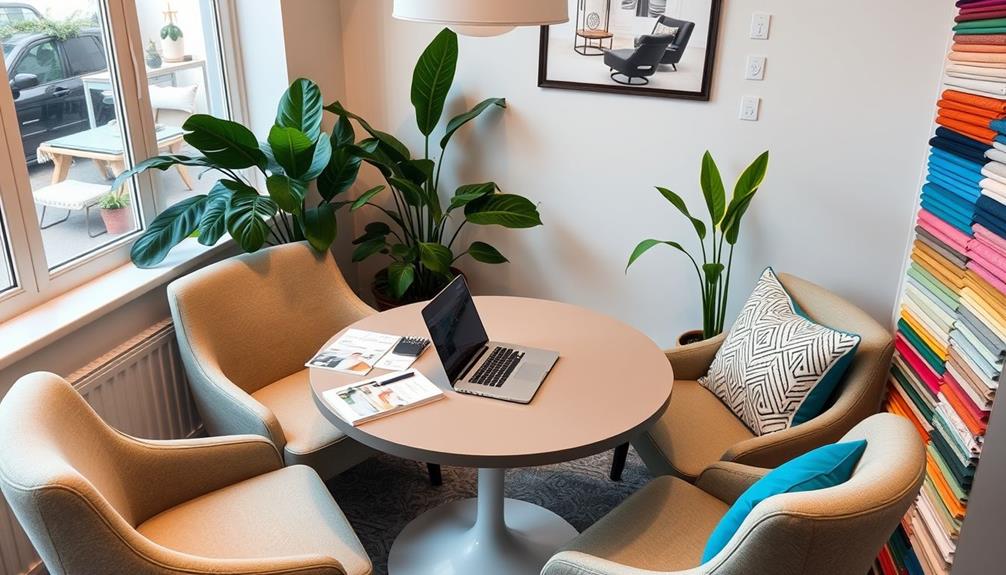
Building strong client relationships is essential for the success of your interior design business. It all starts with initial consultations where you focus on understanding your clients’ needs, preferences, and budgets. This tailored approach sets the stage for effective communication throughout the design process.
Regular updates and check-ins not only enhance client satisfaction but also foster trust.
Creating detailed contracts is vital; they outline project scope, timelines, and costs, helping manage client expectations and reducing the likelihood of disputes. Remember, transparency goes a long way in building rapport.
After project completion, don’t underestimate the value of personal touches. Handwritten thank-you notes or follow-up calls can greatly enhance client interactions and encourage repeat business.
Additionally, actively seek client feedback once the project wraps up. This not only shows your commitment to their satisfaction but also provides insights for service improvements.
Conclusion
So, you’ve set up your interior design business, right? You’ve defined your services, built a portfolio, and even launched a snazzy website. Ironically, while you thought the hardest part was the design, it’s actually mastering the art of client relationships and finances that’ll truly test your skills. Who knew creating beautiful spaces would come with such complex puzzles? Embrace the chaos, because in this business, it’s not just about what’s inside the room; it’s about what’s inside you.









